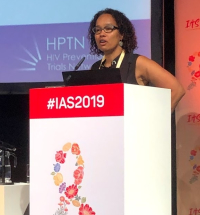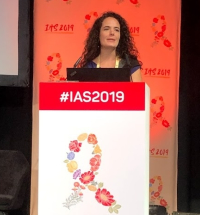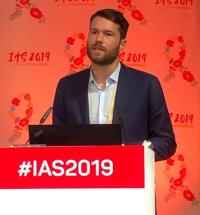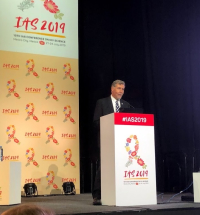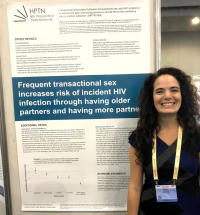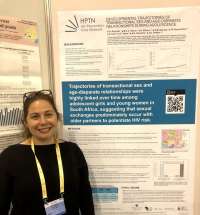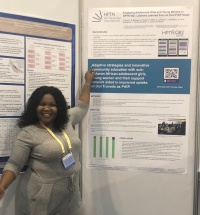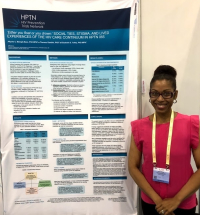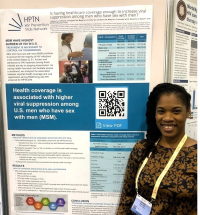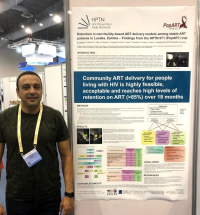IAS 2019

The 10th IAS Conference on HIV Science (IAS 2019) took place 21-24 July at the Centro Citibanamex in Mexico City. The scientific program focused on advances in HIV treatment and cure research, new research on HIV co-infections, the latest progress in biomedical HIV prevention, and insights on vulnerable populations. HPTN researchers presented study data during three symposia/satellite sessions, four oral presentations, and 13 poster presentations. IAS 2019 webcasts, e-posters and links to abstracts are now available online.
Satellite and Symposia Sessions
- Dr. Nyaradzo Mgodi presented Advances in the Field of Broadly Neutralizing Antibodies
- Dr. Myron Cohen presented Long-Acting Injectables for HIV Prevention
- Dr. Richard Hayes and Dr. Sarah Fidler presented HPTN 071 (PopART) Trial: Impact of a UTT Intervention on HIV Incidence
- Dr. William Probert presented Model Projections of the Impact of the PopART Intervention
- Dr. Katharina Hauck presented Cost and Societal Value of the Household-Based Combination HIV Prevention Intervention Implemented in HPTN 071 (PopART)
- Dr. Musonda Simwinga presented Community and Stakeholder Engagement in the HPTN 071 (PopART) Trial
Oral Presentations
Dr. Marie Stoner presented Modelling Combination Interventions Including Increased School Attendance to Prevent HIV Among Girls of School Age in South Africa (HPTN 068). Combination prevention interventions that include increasing school attendance, reducing depression and reducing intimate partner violence may be an effective way to reduce the risk of HIV in adolescent girls and young women in South Africa.
Dr. William Probert presented Quantifying the Contribution of Different Aged Men and Women to Onwards Transmission of HIV-1 in Generalised Epidemics in Sub-Saharan Africa: A Modelling and Phylogenetics Approach from the HPTN071 (PopART) Trial. Results validate predictions of a mathematical model using phylogenetic data. These results support observations there is a significant contribution of young people to HIV transmission in sub‐Saharan Africa, especially 25 to 29-year-old men. These results highlight that if universal testing‐and‐treatment (UTT) does not reach young people, and 25 to 29-year-old men in particular, then the effect of UTT on reducing incidence may be limited.
Dr. Chris Beyrer presented HPTN 078: Primary Results of a Randomized Study to Engage Men Who Have Sex with Men (MSM) Living with HIV Who Are Virally Unsuppressed in the US. HPTN 078 demonstrated that MSM living with HIV, but out of care, are willing to re‐engage when reached, with nearly half achieving and maintaining viral suppression at 12 months. The intervention did not, however, enhance viral suppression; half of the men, overall, were not virally suppressed at 12 months. Greater investment for more intensive interventions is likely needed to address the multiple societal and behavioral challenges among disenfranchised MSM in the US.
Dr. Michelle Andrasik presented The Game-Changing Nature of Early and Ongoing Community Engagement in HIV Prevention Efficacy Trials: The AMP Studies' Experience (HVTN 703/HPTN 081 & HVTN 704/HPTN 085). Community engagement is critical for ethical trial conduct and must be employed in its entirety (education, recruitment, and retention). Early and consistent integration throughout the clinical trial process contributes to improved screening, substantial recruitment, and strong retention.
Dr. Nomhle Khoza presented Measuring Perceptions of Sexual Risk Among Adolescent Girls and Young Women Taking PrEP: A New Qualitative Method Using Visual Timelines in HPTN 082. Self-assessment of risk is challenging when reflecting on intimate relationships. The “visual storytelling” approach using sexual history timelines facilitated discussions and recalibration of personal risk among young African women, who use different parameters than public health professionals to assess risk. This approach is relevant both for researchers seeking to understand the relationship between risk perception and PrEP use, and potentially for providers as a tool to support young women to assess their risk and adopt protective behaviors, including PrEP.
Dr. Connie Celum presented PrEP Adherence and Effect of Drug Level Feedback Among Young African Women in HPTN 082. Most African adolescent girls and young women (AGYW) were taking PrEP in the first 3 months, and a substantial minority had high adherence. Adherence declined significantly, similar to other PrEP studies in youth. PrEP adherence did not increase with the addition of drug level feedback. The four (1%) who acquired HIV were not taking PrEP. This combination prevention package that included PrEP achieved high protection. Research is needed to determine effective adherence support to sustain PrEP use among African AGYW.
Poster Presentations
Dr. Tiarney Ritchwood presented Understanding of Perceived Infectiousness and its Influence on Sexual Behavior Among Individuals with Acute HIV Infection in Lilongwe, Malawi (HPTN 062). Our findings suggest that messages about acute HIV infection (AHI) delivered during the period of AHI are likely beneficial for ensuring that those with AHI understand their level of infectiousness and its association with forwarding transmission and/or HIV reinfection.
Dr. Allysha Maragh-Bass presented 'Either You Float or You Drown:' Social Ties, Stigma, and Lived Experiences of the HIV Care Continuum in HPTN 065. Fewer supportive ties and greater HIV stigma impede medication adherence. Future research will explore these relationships in the larger HPTN 065 participant sample. Low adherence is a stage during which programs must promote skill-building to foster supportive social relationships. Additionally, gender equity-based approaches can facilitate community de-stigmatization of HIV among African Americans, given that women may be at greater risk of negative HIV health outcomes.
Jennifer Velloza presented The Negative Direct Effect of Depressive Symptoms on PrEP Adherence Among High-Risk South African Women in HPTN 067. Depression was common and associated with lower PrEP adherence among South African women after accounting for confounding and mediating variables. Depression screening and services may improve PrEP effectiveness among African women.
Dr. Katherine Rucinski presented Developmental Trajectories of Transactional Sex and Age-Disparate Relationships During Adolescence: An HPTN 068 Analysis. Developmental patterns of transactional sex and age-disparate relationships varied, with most girls estimated to experience a low probability of either that persisted over adolescence. Targeting girls who are at high-risk for transactional sex or an age-disparate relationship early in adolescence could maximize the effectiveness of behavioral and biomedical HIV prevention efforts.
Dr. Stephanie DeLong presented Intimate Partner Violence and Incident HIV Among Adolescent Girls and Young Women in Rural South Africa: HPTN 068. Although lifetime experience of IPV measured at baseline was associated with incident HIV among AGYW in rural South Africa, more proximate, time-varying measures of IPV were not associated with HIV incidence in longitudinal analyses. These findings suggest that the relationship between IPV and HIV incidence is complex, and that additional longitudinal analyses should explore the mechanism by which more distal experiences of IPV impact HIV acquisition.
Dr. Marie Stoner presented Mediators of the Relationship Between Transactional Sex and Incident HIV Infection Among Young Women in South Africa Enrolled in HPTN 068. Both partner age difference and partner number mediate the relationship between transactional sex and incident HIV infection. This suggests that young females with multiple partners serve as a network to high-risk male partners that might render them vulnerable to HIV. However, while these behaviors explain a large portion of the effect of transactional sex on HIV infection, they do not explain the entire effect, indicating that other mediators may also be important.
Dr. Mohammed Limbada presented Retention in Non-Facility-Based ART Delivery Models Among Stable ART Patients in Lusaka, Zambia: Findings from the HPTN 071 (PopART) Trial. Overall patient retention in non-facility based ART delivery models was high (85%) and this was higher in adherence clubs as patients who shifted from study zones could continue going for their club meetings to receive care.
Ab Schaap presented Comparison of Potential Effectiveness of Universal Testing Versus Index Testing: Estimations from 4 Years of Data from the HPTN 071 (PopART) Trial. Data suggests index testing alone would be insufficient to reach UNAIDS “first 90” target and that a combination of strategies needs to be deployed to increase coverage of the knowledge of HIV-positive status.
Dr. Kwame Shanaube presented Impact of a Community-Level Combination HIV Prevention Intervention on Knowledge of HIV Status Amongst Adolescents: Primary Results of HPTN 071 (PopART) for Youth Study. A universal community-level combination of HIV prevention intervention increased knowledge of HIV- status among adolescents. This increase varied by sex, age, country, and community.
Jowanna Malone presented Is Having Healthcare Coverage Enough to Increase Viral Suppression Among Men Who Have Sex with Men in the United States?: Results from HPTN 078. In this analysis, participants with HIV who had healthcare coverage had higher odds of viral suppression. The association between healthcare coverage and viral suppression has important implications as the Trump Administration has made a commitment to end the HIV/AIDS epidemic. These results suggest programs such as the Ryan White Care Act and Medicaid expansion can positively contribute to viral suppression rates among MSM in the U.S.
Thandekile Essien presented Engaging Adolescent Girls and Young Women in HPTN 082: Lessons Learned. HPTN 082 required innovative community education about a new HIV prevention tool (PrEP), and the need to adapt strategies to reach African AGYW and engage their support network. Informing, consulting, involving, collaborating, and empowering AGYW, primary caregivers, and communities contributed to high recruitment and retention of AGYW, who had increased awareness and motivation to use PrEP. The lessons learned may inform community engagement practitioners, research groups, program implementers, policymakers, and study sponsors on how to effectively engage and work with AGYW in HIV prevention.
